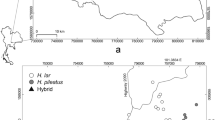Abstract
Hybridization between Alouatta spp. has been suggested at contact zones of A. palliata and A. pigra in Mexico and of A. caraya and A. guariba clamitans in Brazil and Argentina. Whereas genetic data confirmed hybridization between the former pair of species, hybrid individuals of the latter pair have been putatively identified on the basis of a mosaic pelage color. In this paper, we describe the first confirmed cases of hybridization between a female A. guariba clamitans and a male A. caraya. One hybrid male was born in 2007 and one hybrid female was born in 2009 with distinct coat colors. The male resembled the newborn color pattern characteristic of A. guariba clamitans, whereas the female resembled the newborn pattern of A. caraya. The birth and survival of the male hybrid for a year and a half indicated the viability of the heterogametic sex.


Similar content being viewed by others
References
Agoramoorthy G, Hsu MJ (2000) Extragroup copulation among wild red howler monkeys in Venezuela. Folia Primatol 71:147–151
Agostini I, Holzman I, Di Bitetti MS (2008) Infant hybrids in a newly formed mixed-species group of howler monkeys (Alouatta guariba clamitans and Alouatta caraya) in northeastern Argentina. Primates 49:304–307
Aguiar LM, Mellek DM, Abreu KC, Boscarato TG, Bernardi IP, Miranda JMD, Passos FC (2007) Sympatry between Alouatta caraya and Alouatta clamitans and the rediscovery of free-ranging potential hybrids in Southern Brazil. Primates 48:245–248
Aguiar LM, Pie MR, Passos FC (2008) Wild mixed groups of howler species (Alouatta caraya and Alouatta clamitans) and new evidence for their hybridization. Primates 49:149–152
Alonso C, Faria DS, Langguth A, Santee DF (1987) Variação da pelagem na área de intergradação entre Callithrix jacchus e Callithrix penicillata. Rev Brasil Biol 47:465–470
Arnold ML, Meyer A (2006) Natural hybridization in primates: one evolutionary mechanism. Zoology 109:261–276
Bicca-Marques JC, Calegaro-Marques C (1998) Behavioral thermoregulation in a sexually and developmentally dichromatic neotropical primate, the black-and-gold howling monkey (Alouatta caraya). Am J Phys Anthropol 106:533–546
Bicca-Marques JC, Prates HM, Aguiar FRC, Jones CB (2008) Survey of Alouatta caraya, the black-and-gold howler monkey, and Alouatta guariba clamitans, the brown howler monkey, in a contact zone, State of Rio Grande do Sul, Brazil: evidence for hybridization. Primates 49:246–252
Coimbra-Filho AF, Pissinatti A, Rylands AB (1993) Experimental multiple hybridism and natural hybrids among Callithrix species from eastern Brazil. In: Rylands AB (ed) Marmosets and tamarins: systematics behaviour and ecology. Oxford University Press, Oxford, pp 95–120
Cortés-Ortiz L (2009) Genetic and morphological characterization of hybridization of howler monkeys in Mexico. Primate Rep (Spec Issue) 1:12
Cortés-Ortiz L, Bermingham E, Rico C, Rodríguez-Luna E, Sampaio I, Ruiz-García M (2003) Molecular systematics and biogeography of the Neotropical monkey genus, Alouatta. Mol Phylogenet Evol 26:64–81
Cortés-Ortiz L, Duda TF Jr, Canales-Espinosa D, García-Orduña F, Rodríguez-Luna E, Bermingham E (2007) Hybridization in large-bodied New World primates. Genetics 176:2421–2425
Fialho MS, Setz EZF (2007) Extragroup copulations among brown howler monkeys in southern Brazil. Neotrop Primates 14:28–30
Gregorin R (2006) Taxonomia e variação geográfica das espécies do gênero Alouatta Lacépède (Primates, Atelidae) no Brasil. Rev Brasil Zool 23:64–144
Horwich RH (1983) Breeding behaviors in the black howler monkey (Alouatta pigra) of Belize. Primates 24:222–230
Kowalewski MM, Peker SM, Zunino GE (2005) Promiscuous howlers: extra-group copulation in female Alouatta caraya in northern Argentina. In: Bicca-Marques JC (ed) Programa e livro de resumos do XI Congresso Brasileiro de Primatologia. Sociedade Brasileira de Primatologia, Porto Alegre, p 116
Mendes SL (1997) Hybridization in free-ranging Callithrix flaviceps and the taxonomy of the Atlantic Forest marmosets. Neotrop Primates 5:6–8
Peres CA, Patton JL, Silva MNF (1996) Riverine barriers and gene flow in Amazonian saddle-back tamarins. Folia Primatol 67:113–124
Silva BTF, Sampaio MIC, Schneider H, Schneider MPC, Montoya E, Encarnación F, Salzano FM (1992) Natural hybridization between Saimiri taxa in the Peruvian Amazonia. Primates 33:107–113
Acknowledgments
We thank Liliana Cortés-Ortiz and an anonymous reviewer for constructive comments on an earlier version of this manuscript. JCBM also thanks the Brazilian National Research Council for a research fellowship (CNPq #306090/2006-6 and 303154/2009-8).
Author information
Authors and Affiliations
Corresponding author
About this article
Cite this article
de Souza Jesus, A., Schunemann, H.E., Müller, J. et al. Hybridization between Alouatta caraya and Alouatta guariba clamitans in captivity. Primates 51, 227–230 (2010). https://doi.org/10.1007/s10329-010-0192-8
Received:
Accepted:
Published:
Issue Date:
DOI: https://doi.org/10.1007/s10329-010-0192-8




